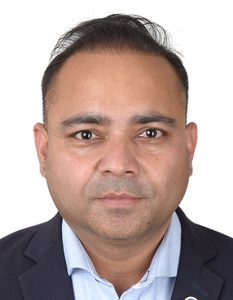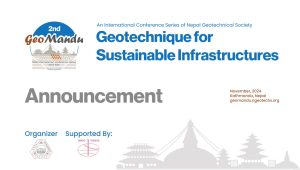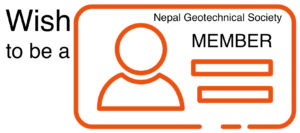Seniors’ Insight: NGS Interview Series 1

An Interview Series with Senior Members of Nepal Geotechnical Society
Er. Dr. Gyaneswor Pokharel, Ph.D., P.E. (VA, MD, NY, CT, FL), Senior Geotechnical Engineer and one of the key founder members of Nepal Geotechnical Society
 Profile:
Profile:
Place of Birth: Pokhara, Nepal
Current Residence: Morris Plains, NJ, USA
1988 Bachelor’s Degree, Hons. (civil engineering, IIT Roorkee, India
1991 Master in Civil/Geotechnical Engineering, AIT, Thailand
1995 Ph.D. Engineering, Nagoya University, Japan
1995-1997 Yahagi Constructions Co., Nagoya, Japan
1997-2000 Public Works Research Institute, Tsukuba, Japan
2000-2003 Faculty, Gifu University, Japan
2003-2004 Geotechnical Engineer, Geopier Foundation Systems Inc. Blacksburg, VA, USA
2003-2004 Geotechnical Engineer, Virginia Tech. Blacksburg, VA, USA
2004-2012 Associate Professor, MSU Beckley, WV, USA
2012-2013 Visiting Professor, Purdue University, West Lafayette, USA
2013-2015 Civil/Geotechnical Engineer, Director of Engineering, AET Inc. New Haven, CT, USA
2015-2016 Senior Field Geotechnical Engineer, Langan Engineering, HQ, NJ, USA
2016-2017 Lead Geotechnical Engineer, Matrix New World Engineering, Florham Park, NJ, USA
2017-2018 Lead Project Engineer (Groundwork), MBSI, Elkridge, MD, USA
Q1: Sir, first of all, could you please briefly tell us about yourself and your current job responsibilities?
My name is Gyaneswor Pokharel. At the outset, I wish all the best to all NGS community in the auspicious occasion of 25th Anniversary of NGS.
Let me first explain my professional endeavor in last 30 years. I got my Bachelor of Civil Engineering Degree from the Indian Institute of Technology (IIT), Roorkee, formerly University of Roorkee in 1988. Then, I worked in Nepal for one year at three different government entities, Nepal Electricity Authority, Engineering Directorate, then District Water Supply Office in Lalitpur, and Groundwater Development Project, Babar Mahal Office. In September 1989, I went to Bangkok to study Master of Engineering (Civil/Geotechnical) at Asian Institute of Technology (AIT), and graduated in 1991. I had a chance to work in AIT as a Research Associate for about a year. Then, I joined Nagoya University of Japan in 1992 as a Ph. D. candidate and got a Ph. D. Degree in March 1995. After that, I worked for Yahagi Constructions Co. Ltd., Nagoya for two years as a research engineer, and I was involved in soil nailing technology. When my contract with Yahagi Constructions was about to end, I got an offer to join Public Works Research Institute (PWRI) under the Ministry of Construction, as a JSPS Post-Doctoral Research Fellow. During this period, I was involved in centrifuge testing of reinforced clay and sand slopes. I performed more than 100 tests in the centrifuge testing machine, and it was one of the great opportunities for me to work with sophisticated machines. I also got opportunities to work in a few slope stability study projects related to highways and river levees. I also worked briefly on full scale model testing of micropile technology.
 While at PWRI, Prof. Madan B. Karkee introduced me to JSCE (Japanese Society of Civil Engineers) editorial board, and I was inducted to the editorial board as an editor in 1999, where I served for two years. In the editorial board, I had an opportunity to work with several distinguished professors and professionals, particularly, Prof. R. Yatabe of Ehime University. Then , in 2000, I had to move to Gifu University as a faculty member, where I taught soil mechanics and laboratory experiments to undergraduate students, supervised undergraduate and graduate students as their research advisor. I was there for 3 years. After that, I moved to Virginia Tech, Blacksburg, USA as a visiting faculty, and was involved in research of stability of horizontal bore holes for gas exploration, a project sponsored by ConocoPhillips. In 2004 through 2012, I worked in Mountain State University as an Associate Professor, teaching primarily engineering and science subjects.
While at PWRI, Prof. Madan B. Karkee introduced me to JSCE (Japanese Society of Civil Engineers) editorial board, and I was inducted to the editorial board as an editor in 1999, where I served for two years. In the editorial board, I had an opportunity to work with several distinguished professors and professionals, particularly, Prof. R. Yatabe of Ehime University. Then , in 2000, I had to move to Gifu University as a faculty member, where I taught soil mechanics and laboratory experiments to undergraduate students, supervised undergraduate and graduate students as their research advisor. I was there for 3 years. After that, I moved to Virginia Tech, Blacksburg, USA as a visiting faculty, and was involved in research of stability of horizontal bore holes for gas exploration, a project sponsored by ConocoPhillips. In 2004 through 2012, I worked in Mountain State University as an Associate Professor, teaching primarily engineering and science subjects.
I also have an experience of working as General Secretary of ASCE (American Society of Civil Engineers) West Virginia Section for two years. I was the editor of the section’s news letter. In 2012, I moved again to Purdue University as a Visiting Professor and taught Statics to two classes of 80 and 120 students in fall and spring semesters. I was also involved in various geotechnical engineering research topics.
In 2013, I joined a materials testing and consulting company in New Haven, Connecticut and worked there for two years. I had to inspect and perform geotechnical investigations and design various geotechnical structures and pile foundations including the design of commercial, academic, and residential buildings. After that, I joined Lagan Engineering in Head Office in New Jersey. Subsequently, I joined Matrix New World Engineering in the same area, and was involved in geotechnical consulting work for one year as a lead geotechnical engineer. In 2017, I moved to Maryland and joined a company specialized in support of excavations as a team leader. Now, I am working for Jacobs Engineering Group, a design build company, since November 2018. My role is Senior Geotechnical Engineer. My projects span from railway to highway, tunnels, flood gates in New York, and rock blasting. Currently, I live in Morris Plains, NJ, USA.
 So as of today, I have over 30 years of professional experience in diverse fields of geotechnical engineering. I am experienced in civil/geotechnical analysis and foundation designs for residential and commercial structures, and have prepared detailed reports on geotechnical and structural investigations, and have recommended solutions. I have provided engineering reports related to analysis and design of foundations and superstructures, on‐site and lab investigations, and construction projects. I have also performed QA/QC and construction oversight of steel, wood, foundation, and soil structures. I have managed CMT and special inspector for residential and commercial buildings, road, and parking lots and have supervised/ inspected construction works on behalf of the project owner as a Senior Field Engineer. I have professional engineer’s license, P.E. of five states of the USA.
So as of today, I have over 30 years of professional experience in diverse fields of geotechnical engineering. I am experienced in civil/geotechnical analysis and foundation designs for residential and commercial structures, and have prepared detailed reports on geotechnical and structural investigations, and have recommended solutions. I have provided engineering reports related to analysis and design of foundations and superstructures, on‐site and lab investigations, and construction projects. I have also performed QA/QC and construction oversight of steel, wood, foundation, and soil structures. I have managed CMT and special inspector for residential and commercial buildings, road, and parking lots and have supervised/ inspected construction works on behalf of the project owner as a Senior Field Engineer. I have professional engineer’s license, P.E. of five states of the USA.
Q2: We have come to know that you are one of the key founder members of Nepal Geotechnical Society, and you all founded this society back in 1994. How did you think of founding Nepal Geotechnical Society and how was it possible then?
In 1991, Professor Balasubramaniam (Bala) of AIT, Bangkok organized the 9th Asian Regional Conference on Soil Mechanics and Foundation Engineering in Bangkok, and I was also a volunteer of this conference. In the conference, there were many renowned distinguished professors of geotechnical engineering participating from the world such as Prof. Harry Poulos, Prof. Ishihara, Prof. Tatsuoka, and many others. I was given a responsibility to help these professors in the media room arrange their presentation OHPs and slides. I got a great opportunity to meet these distinguished people and representatives of the national societies, but unfortunately, I could not see Nepal in the map of ISSMFE (International Society for Soil Mechanics and Foundation Engineering; now ISSMGE) national societies. Late Prof. Tej B. S. Pradhan, who was a Nepalese professor in Japan, was also there in the conference. I met him for the first time, and we had lunch together the next day in AIT. While talking to him, I hinted of having a geotechnical society in Nepal too. Upon joining Nagoya University, I met him several times, and wrote a letter to him for his support in establishing Nepal Geotechnical Society (NGS). I started evolving the idea of NGS. My cousin Parameshor Pokharel helped me in this regard, and my friend Laxman Sunuwar provided additional support to make it happen. At that time, we did not have that many Nepali Geotechnical Engineers in Nepal, and the number was below threshold to boost interest from active geotechnical engineers. That required me to get help from other non-geotechnical engineers.
 Eventually, in May 1994, Nepal Geotechnical Society was registered with the Government of Nepal. Parameshor tried to reach fellow geotechnical engineers, but the outcome was not so promising. Then, in 1995, NGS got national society status of ISSMGE, and in 1999, we got national society status of ISRM (International Society of Rock Mechanics) too. Prof. Pradhan represented NGS in the 14th ICSMGE in 1997, and presented a national report on Geotechnical Projects in Nepal prepared by Dr. Laxman Sunuwar. It was our first presence in the ISSMGE council meeting. Nepal was finally in the map of ISSMGE national societies. Since 1995 through 2003, many Nepali Geotechnical Engineers living in Japan contributed heavily to enhance the growth of NGS. Through this message, I appreciate the role played by Prof. Madan B. Karkee, Dr. Sukh Gurung, Dr. Tara N. Lohani, Dr. D. Shiwakoti, Late Dr. Tej B. S. Pradhan and many others.
Eventually, in May 1994, Nepal Geotechnical Society was registered with the Government of Nepal. Parameshor tried to reach fellow geotechnical engineers, but the outcome was not so promising. Then, in 1995, NGS got national society status of ISSMGE, and in 1999, we got national society status of ISRM (International Society of Rock Mechanics) too. Prof. Pradhan represented NGS in the 14th ICSMGE in 1997, and presented a national report on Geotechnical Projects in Nepal prepared by Dr. Laxman Sunuwar. It was our first presence in the ISSMGE council meeting. Nepal was finally in the map of ISSMGE national societies. Since 1995 through 2003, many Nepali Geotechnical Engineers living in Japan contributed heavily to enhance the growth of NGS. Through this message, I appreciate the role played by Prof. Madan B. Karkee, Dr. Sukh Gurung, Dr. Tara N. Lohani, Dr. D. Shiwakoti, Late Dr. Tej B. S. Pradhan and many others.
Q3: Have you found any changes in perception of the field of geotechnical engineering in Nepal then and now?
Sure, I have. As I said above, the number of geotechnical engineers at the time of early registration of NGS was probably less than a dozen, and now, we have our own MS/ME programs in Nepal at different academic institutions, particularly, at Institute of Engineering, Pulchowk Campus. Back in 2003, Dr. B. R. Shahi and Mr. Tuk Lal Adhikari jointly organized the first one day conference, which I had a great opportunity to participate in. At that time, majority of the participants were graduate students of Institute of Engineering Pulchowk Campus. Now, I have heard that there are more than 100 geotechnical engineers in Nepal. Since Dr. Netra Prakash Bhandary has taken the lead with the support of Mr. Tuk Lal Adhikari and other colleagues, NGS has crossed many mile stones particularly by organizing national and international conferences and lecture series. I am very optimistic that NGS will be recognized as a great player in national geotechnical projects as well as in regional and international arena.
Q4: This year marks the 25th anniversary of NGS. Do you think we have achieved much in this field in these 25 years?
I have certainly observed it. As I stated above, total number of geotechnical engineers in Nepal was less than a dozen 25 years ago, but now, the number has crossed the threshold to move ahead without any risk of turning to a passive state. Since Dr. Netra Prakash Bhandary from Japan and Mr. Tuk Lal Adhikari in Nepal started to work as a team, NGS has achieved a lot. Thanks to their leadership. As Nelson Mandela once said, “what a person can do, inspire others.” Dr. Bhandary has inspired NGS to move ahead, exponentially, every day.
Q5: We have also come to know that many of the senior members of NGS including you, who were very active in the past have now left Nepal and have been residing abroad. Do you think this is one of the reasons for less development of NGS and its activities in Nepal?
Success of any organization depends on mentoring next generation leader, then hand over to them, so that they can lead the organization. It is how human society has evolved over thousands of years. Similarly, the professional societies grow and evolve, and NGS is no exception. In this process, we may have witnessed short up and down hills and saddle points. In bigger picture, the senior members of NGS have contributed what they could, tried their best to mentor next generation leaders, and paved a way for next generation leaders. In that sense, NGS is a great role model professional society in Nepal, and because of such passing of torch to next generation leaders, it has not inherited a negative side of many other professional societies where non-productive senior members hold positions and do not let the societies move in professional manner so as to achieve professional goals, objectives, and missions. We are in right direction. I believe so!
Q6: How do you think members like you, who are stationed abroad and work in advanced projects can help NGS do much better in the homeland?
I believe the best way to help would be having webinars and face-to-face lectures while these experienced professionals visit Nepal. We should tap it. Then, you can stream it online and reach all those members who cannot access the lectures in real time. In the US, if you are a professional engineer, you need to have in average one PDH (Professional Development Hours?) almost every month, and keep your knowledge up-to-date. Similarly, we can tap these professionals as an important resource to enhance knowledge and skill of geotechnical engineers in Nepal. The professionals working in developed countries can bring current ongoing research topics and different codes in addition to technologies used in current large projects. This should be the mission of NGS to transfer technology to Nepal. NGS can be bridge the two sides.
Q7: We have come to know that you studied in India, Thailand and Japan, and have worked in Japan and the USA. How would you like to share your experience in study and work with our young engineers and geoscientists?
Well, like I stated above, the best way would be to share knowledge, experience, and skill through webinars, conferences, workshops, and lecture series. The professionals in Nepal who sometimes face complicated problems and need their solutions, NGS may be tapped as a resource to get help of the professionals who live abroad and have enough past experience to provide support to find solutions to the problems. In Japan, somewhere in the year 2000, they started creating a database of professionals and researchers to find quick access to a right professional to provide or seek support on a problem. I believe it was a great success. You can still find my resume in their database. I believe NGS can work with NAST and create a database of professional Nepali Geotechnical Engineers around the world, and let those who need their service access the information. We should tap and share knowledge before the resources goes off that radar. NGS should be our knowledge sharing warehouse.
Q8: How important do you think the field of geotechnical engineering is in Nepal in context of building earthquake-resistant infrastructures?
We should first understand the essence and power of geotechnical engineering knowledge, skill, experience, and technology, then apply it to practice of geotechnical engineering in Nepal. We need to create a database. We also need zoning. We may start with simple zoning based on past few earthquakes in Nepal, and the damages experienced in the aftermath of these earthquakes. Then, we may push for legislation and codes or regulation. Without zoning, these regulations do not function and the public will have resistance. We should create a framework so that future engineers can patch up and raise the bar to provide safe and risk free place to live, work, and enjoy life.
Q9: Finally, would you like to say anything further to all NGS community?
 Thanks to all the past and present geotechnical professionals who helped grow and evolve NGS to this size, and I have great satisfaction to get this opportunity to celebrate the 25th anniversary. A special thanks goes to current executive team under the leadership of Prof. Bhandary for organizing such a wonderful event online and offline. Nepal being a mountainous country, where the elevation of 8,848 meters drops to almost 100 meters in just less than 100 km, has great expectations from the field of geotechnical engineering, and the future of geotechnical engineers is bright and prosperous, no matter where you live and work in Nepal. Geotechnical engineering is not only a science that you can predict events based on scientific knowledge, but it also is an art. I mean that as you grow and get experienced, your scope gets wider and wider. A geotechnical engineering professional, therefore, will never be old and obsolete. That is the beauty of geotechnical engineering in Nepal.
Thanks to all the past and present geotechnical professionals who helped grow and evolve NGS to this size, and I have great satisfaction to get this opportunity to celebrate the 25th anniversary. A special thanks goes to current executive team under the leadership of Prof. Bhandary for organizing such a wonderful event online and offline. Nepal being a mountainous country, where the elevation of 8,848 meters drops to almost 100 meters in just less than 100 km, has great expectations from the field of geotechnical engineering, and the future of geotechnical engineers is bright and prosperous, no matter where you live and work in Nepal. Geotechnical engineering is not only a science that you can predict events based on scientific knowledge, but it also is an art. I mean that as you grow and get experienced, your scope gets wider and wider. A geotechnical engineering professional, therefore, will never be old and obsolete. That is the beauty of geotechnical engineering in Nepal.
Once again, I wish all the best to the entire NGS community in the auspicious occasion of its 25th Anniversary. Happy New Year 2076! Namaste.
Thank you and we wish you all the best!






